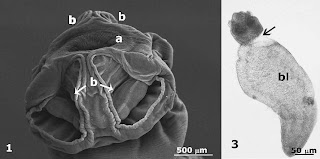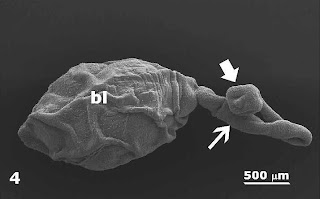In June 2010 at Folly Beach, South Carolina, the local community was shocked and dismayed by the sight of
millions of dead dwarf surf clams (
Mulinia lateralis) that carpeted the beach with rotting shellfish. During the course of an investigation into what might have caused this die-off, researchers discovered some tapeworm larvae in the clams which had not been previously reported from that area.
 |
| image of Duplicibothrium minutum from figures in the paper |
Because the larval stages of tapeworms have few of the morphological features that usually serve as diagnostic markers to identify different species, the researchers looked to their DNA for clues on their identity. They sequenced a section of the tapeworms' DNA and compared it with known DNA sequences of tapeworms (we have previously featured a study which used the same technique, know as DNA barcoding, to figure out the life cycle of a
Great White shark tapeworm.) They were able to determine that the most common species of parasite in those clams was the tapeworm we are featuring today;
Duplicibothrium minutum. Out of the 200 clams that the researchers dissected, 150 of them were infected with
D. minutum, while four of clams were infected with another species of tapeworm -
Rhodobothrium paucitesticulare (three of which were also infected with
D. minutum).
 |
photo of Rhodobothrium paucitesticulare
from figures in the paper |
The larvae of these two tapeworms occupied different part of the clam's body - whereas
D. minutum were often found in pairs in the bivalve's digestive glands,
R. paucitesticulare larvae tucked themselves away at the gap just beneath the clam's fleshy mantle. Both tapeworms are gut parasites of the Cownose ray, (
Rhinoptera bonasus) which commonly feed on mollusks and other invertebrates that they suck up from sandflats and crush with their hard dental plates.
Rhodobothrium paucitesticulare only infects the dwarf surf clam and one other species of clam (
Donax variabilis), while
D. minutum has a much wider host range and has also been found in two other species of clams (
Donax variabilis and
Angulus versicolor) as well as the Florida crown conch (
Melongena corona).
Unlike some parasitic flukes that can
alter the burrowing behaviour of clams and other bivalves, neither tapeworm caused much noticeable harm to the host clams. The presence of
D. minutum caused some minor enlargement at the opening of the digestive glands, but there were no signs of inflammation, and the
R. paucitesticulare larvae seem to be completely benign and did not affect the clam's health at all. So while those tapeworms seems to be very common in the clam population, they were not causing nearly enough harm to be considered responsible for the mass die-off.
Reference:
de Buron I, Roth PB, Bergquist DC, Knott DM. (2013)
Mulinia lateralis (Mollusca: Bivalvia) die-off in South Carolina: discovery of a vector for two elasmobranch cestode species.
Journal of Parasitology 99: 51-55
No comments:
Post a Comment